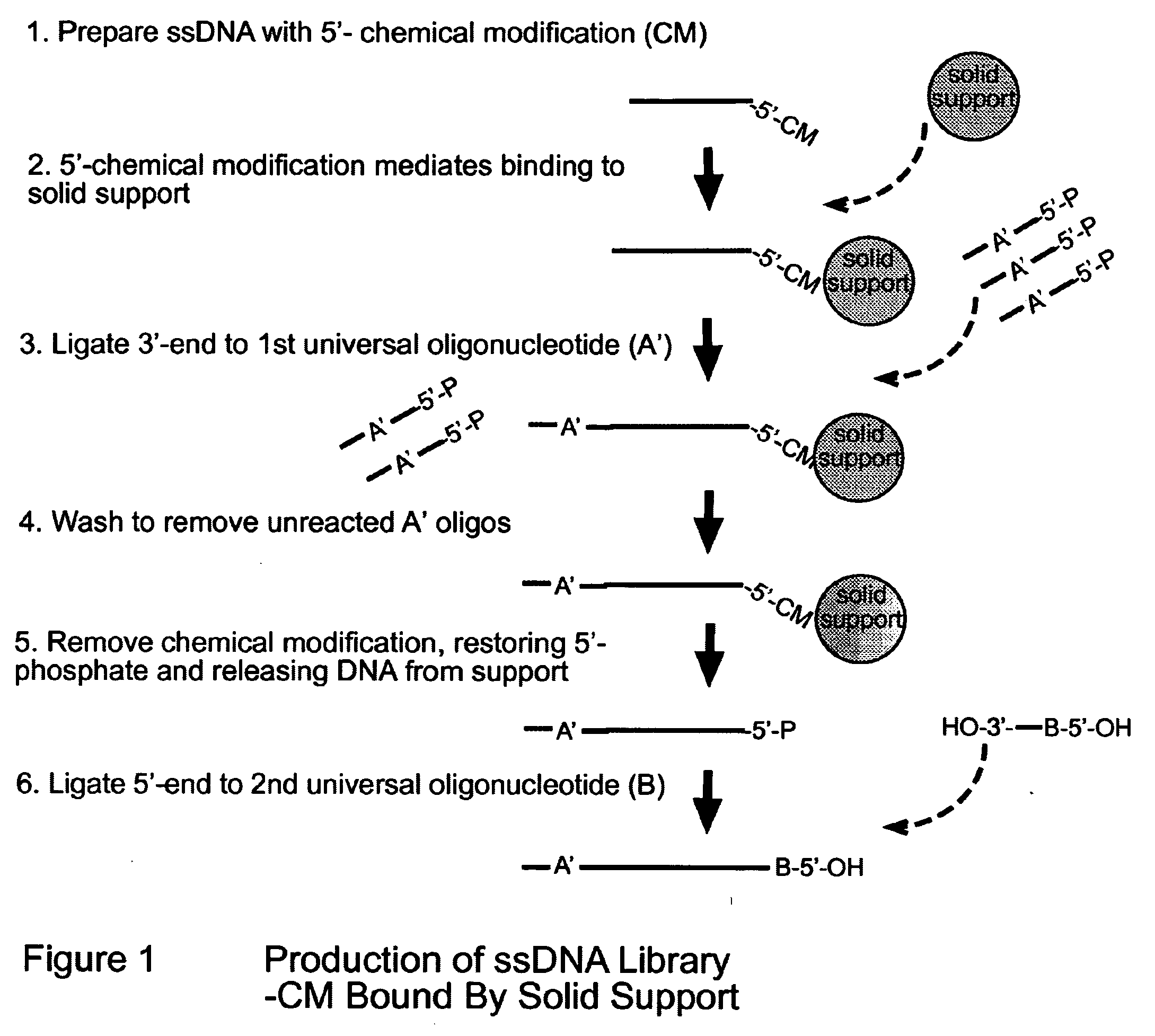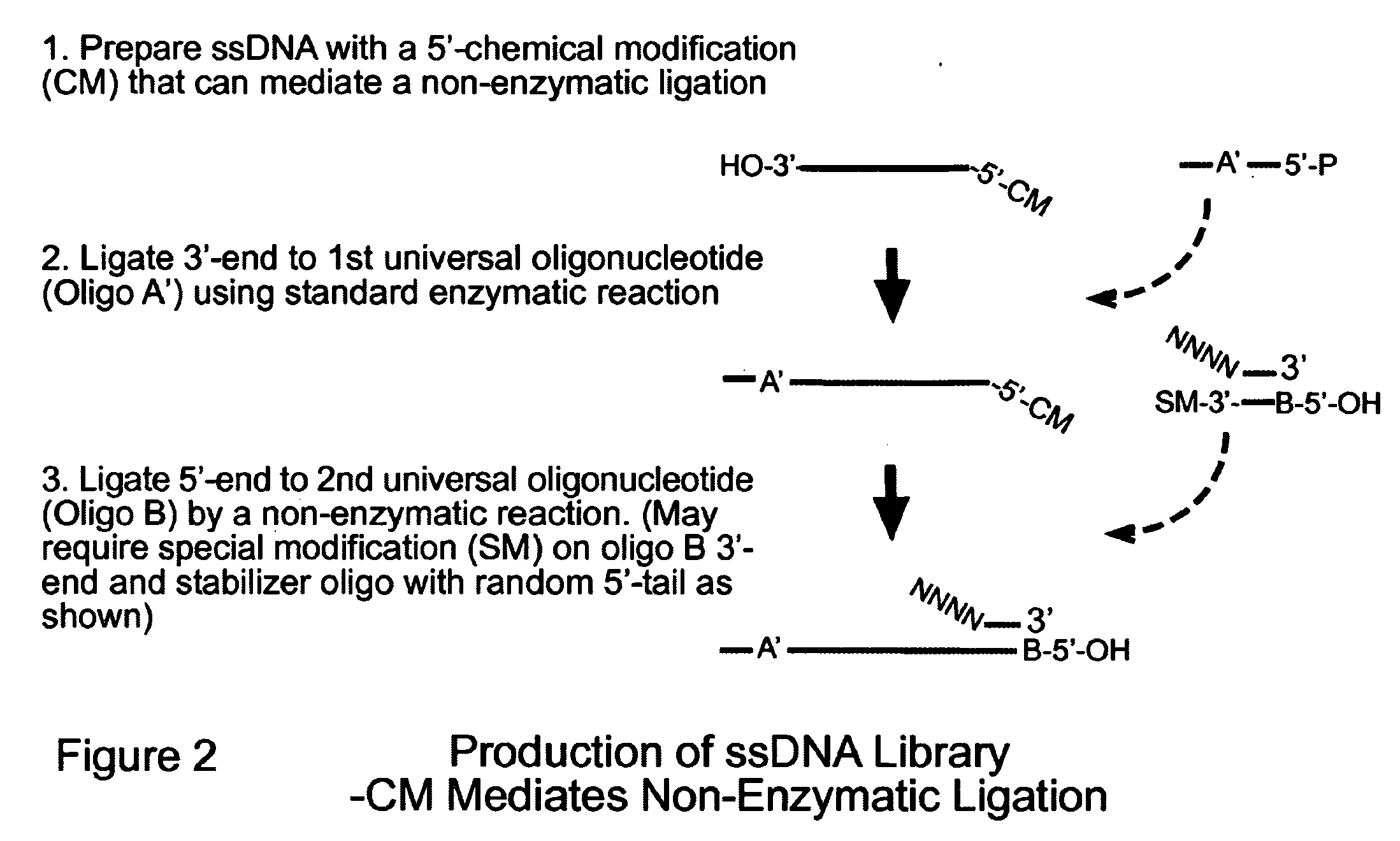Novel Process for Construction of a DNA Library
- Summary
- Abstract
- Description
- Claims
- Application Information
AI Technical Summary
Benefits of technology
Problems solved by technology
Method used
Image
Examples
example 1
Library Construction from Template RNA
[0121] The following is an example of how library construction from template RNA could be performed according to an embodiment of the present invention.
[0122] Oligonucleotides: All oligonucleotides are obtainable from Integrated DNA Technologies. Oligonucleotide R-PC is a random hexamer with a photocleavable biotin group (PC-biotin) attached to the 5′-terminus and a 3′-hydroxyl group. It is used to prime reverse transcription. The sequence of R-PC is 5′-NNNNNN-3′ (SEQ ID NO:5).
[0123] Oligonucleotide B-1 has a 5′-hydroxyl group, a 3′-hydroxyl, and contains the T7 bacterophage promoter sequence (underlined). It is used for ligation to the 5′-terminus of single stranded cDNA. The sequence of B-1 is 5′-GGTAATACGACTCACTATAGG-3′ (SEQ ID NO:6).
[0124] Oligonucleotide A′-1 has a 5′-phosphate group, a 3′-amino group and contains the reverse complement of the T3 bacteriophage promoter sequence (underlined). It is used for ligation to the 3′-terminus of...
example 2
Library Construction from Double-Stranded DNA Template
[0135] The following is an example, according to one embodiment of the present invention, of how library construction from double-stranded DNA template oligonucleotides could be performed. Oligonucleotides used are the same as for Example I (above).
[0136] Depurination of DNA: One hundred nanograms (100 ng) of rat liver genomic DNA is dissolved in 10 ul of 10 mM Tris-Cl pH 7.5, 0.1 mM EDTA and heated to 95° C. for 5 minutes in an 0.2 ml polypropylene tube. The DNA is snap-cooled on wet ice.
[0137] Synthesis of ssDNA: Ten microliters (10 ul) of a mixture containing 40 mM Tris-Cl pH 8.8, 20 mM (NH4)2SO4, 20 mM KCl, 4 mM MgSO4, 0.1 %Triton X-100, 400 uM dATP, 400 uM dCTP, 400 uM dGTP, 400 uM dTTP, and 20 uM R-PC oligonucleotide is added to the depurinated DNA. 16 units of Bst I DNA polymerase in a volume of 2 ul is added to the mixture. The tube containing fragmented DNA, reagent mixture, and Bst I polymerase is incubated for 15 mi...
example 3
Preparation of Biotinylated Complementary RNA Suitable for Microarray Hybridization
[0141] An 8.5 kb in vitro-transcribed RNA derived from the Hepatitis C virus (HCV) genome was initially used for optimization of key steps in ORB-AMP™. To test conditions for template fragmentation, the 8.5 kb RNA was heated to 83° C. for 3 minutes in the presence of calcium, magnesium, or zinc cations. Fragments were prepared using the acetate salts of each cation at concentrations ranging from 0.002 mM to 200 mM (FIG. 6, A-C). Heating in the presence of any of these cations resulted in uniform smears of degraded RNA, suggesting that cleavage of the RNA was random or semi-random. The concentrations of calcium and magnesium cations required for fragmentation of the HCV transcript were similar. Heating in 2 mM calcium or magnesium completely eliminated the original 8.5 kb band, and heating in 20 mM of the cations produced RNA fragments averaging 700 nucleotides or less in size (FIG. 6, A-B). In contra...
PUM
 Login to view more
Login to view more Abstract
Description
Claims
Application Information
 Login to view more
Login to view more - R&D Engineer
- R&D Manager
- IP Professional
- Industry Leading Data Capabilities
- Powerful AI technology
- Patent DNA Extraction
Browse by: Latest US Patents, China's latest patents, Technical Efficacy Thesaurus, Application Domain, Technology Topic.
© 2024 PatSnap. All rights reserved.Legal|Privacy policy|Modern Slavery Act Transparency Statement|Sitemap



